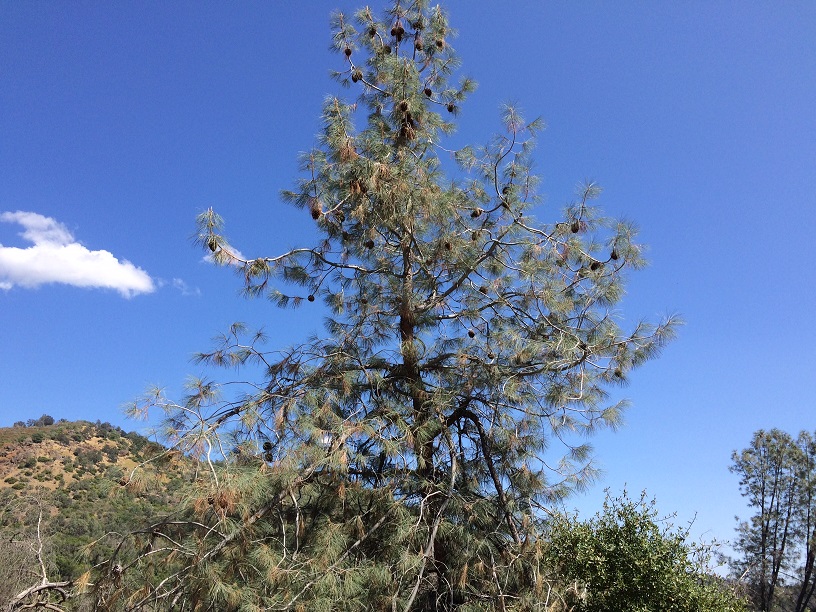

Gray Pine heavy with pine cones, Stockton Creek Trail, near Mariposa water treatment plant. Photo copyright © 2019 Mariposa Native Plants
A large native pine tree found from Oregon, across northern California, in the Coast Range, in the Sierra foothills, and south into the mountains north of Los Angeles. Without a doubt, the least attractive of all the pines, it is nevertheless an important component of the ecosystems surrounding the Central Valley. It has gray-green leaves a rounded top, and its trunk tends to fork as the tree ages. The cones are large and spiny.
Elevation: sea level to 5,000 ft. (1500m). P.sabiniana is found in Mariposa County above 1,000 ft. It is a typical companion tree in the Blue Oak (Quercus douglasii) savannahs of western Mariposa County. Sun: partial or full. Temperature: cold tolerant to -20°F (-30°C). Soil: poor, clay, loamy, or sandy; pH 5-8.
Pine trees are somewhat difficult to transplant. This tree needs a site that is well-drained and partly shaded. A good spot to plant young pine trees is on the shady side of an old stump. The roots are sensitive to disturbance; avoid breaking the root ball when planting from the container. The best time to plant them from a container is in the fall. Drench the ground around the tree with water after planting, making sure that the top of the root ball is level with ground around the tree. Water (2 gallons, 8 liters) once per week in the first summer. Water no more than once per month, in the same amounts, in the second summer. Thereafter, no supplemental water should be required. If the third spring before summer is especially dry, then water in the third summer as in the second. Thereafter, no supplemental water should be required.
P.sabiniana is a host plant for a number of butterflies and birds. Scrub Jays, Red-Shafted Flickers, and Band-Tailed Pigeons feed on the seeds of the Gray Pine. Deer browse on the needles and twigs. Black bears feed on the foliage, seeds, and even the bark of Gray Pines. Gray Pine woodland is a preferred habitat for deer, California Quail, and Mourning Dove.
Gray Pine occurs with Blue Oak (Quercus douglassii) in the foothills surrounding the California Central Valley foothills. Gray Pine has been planted for purposes of erosion control. It can be established on water-deficient sites, those with limestone soil, those with serpentine soil, and where calcium is deficient.
Gray Pine seeds were eaten as an important diet component by Native Americans. The needles were woven into baskets by California Natives.
Seeds from cones (12/bag).